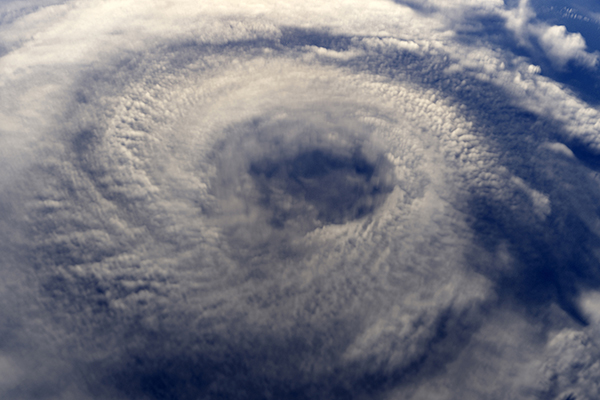



| By Dr. Ronald Hoffman

A year ago, Hurricane Harvey came barreling into the Houston area. Now Florence has wrought widespread destruction and catastrophic flooding on the Carolinas. This week, I’m reprising an article I wrote in the wake of Harvey, newly applicable to Florence. While some of the specific environmental pollutants vary due to regional differences, some (like mold) are universal threats in the aftermath of any storm that causes extensive water damage.
The novel menace is that North Carolina is a repository for coal residues—there are scores of coal ash pits that are inadequately protected from flooding. If their contents are unleashed on surrounding lands and waterways, there’s a major risk of contamination with arsenic, cadmium, mercury and other environmental toxins.
Additionally, North Carolina is America’s second biggest producer of pork. The pigs are raised on huge industrialized farms, and the resultant waste is channeled into gigantic manure “lagoons.” These are in danger of overflowing their banks, with inevitable spillage. When the waters eventually recede, Carolinians may face an unprecedented assault on their olfactory senses. Rivers, lakes and reservoirs may be contaminated indefinitely.
Let’s pray for our fellow citizens and wish them Godspeed in surmounting the challenges ahead. And let these natural catastrophes prompt us to undertake better preparedness to avoid compounding Nature’s destruction with human error borne of complacency and greed.
The flood waters are finally receding from the Texas-Louisiana Gulf Coast, but the long-term health consequences of Harvey are only just now becoming apparent. Sure, there were dozens of deaths due to drowning and even electrocution, but these were only the most obvious signs of devastation. More hazards lurk.
First, let’s realize that massive flooding has unleashed a gargantuan tide of raw sewage and dangerous petrochemicals. The Houston-New Orleans corridor is the epicenter of the chemical industry. The detritus spilled into the air and water will have immediate toxic effects; even more problematic will be the lingering impact on the soil in which plants grow and children play.
As rescue workers and inhabitants wade through this toxic soup, they’ll be exposed to poisonous chemicals and pathogens. The potential for injury from submerged objects is huge; even small lacerations offer a portal of entry for dangerous microbes.
Earlier this year, a man died after swimming in Gulf waters within days of getting a tattoo. The cause of death was septicemia from Vibrio vulnificus, a cholera-like bug known to inhabit South Texas coastal waterways. The recent tattoo gave the bacteria a pathway into the bloodstream, and the victim’s immune system, compromised by alcoholic cirrhosis, was overwhelmed.
Countless thousands of Houston area dwellers are virtually dependent on life support from the region’s hospitals: dialysis patients, those requiring checkups to adjust their anti-coagulant medication, people who need their pacemakers adjusted, to name but a few. Others take multiple medications, some of which weren’t retrieved when they hastily abandoned their homes. With hospitals and pharmacies inundated, they’re running out of meds to control hypertension, diabetes, prevent blood clots, maintain tolerance to transplanted organs, and to keep mental disorders in check. Their overworked health care professionals are dispersed in distant improvised facilities, scrambling to source essential medical supplies.
Refugees from the flood, many Texans are shoehorned into relocation centers where sanitary conditions and crowding will facilitate the spread of infectious diseases, especially among the aged, the very young, and the immunosuppressed.
Stagnant groundwater will accelerate the breeding of mosquitoes that may transmit West Nile and Zika virus during the long warm months ahead.
A more insidious but equally real problem is the PTSD engendered by the experience of loss and dislocation. Harvey will cast a long shadow over the future psychological health of survivors.
But the worst scourge of all, as it is from all floods, will be from toxic mold. All surfaces that came in contact with the flood waters will be vulnerable to mold infestation. Drying and chemical treatment is insufficient to mitigate the risk; furniture, clothing, and construction materials will need to be systematically rooted out, discarded and replaced. Houses and businesses, seemingly intact after the flood waters recede, will have to be dismantled and entirely rebuilt.
The risk posed by mold goes well beyond just asthma and respiratory symptoms. Mycotoxins from mold species like Stachybotrys are profoundly immunosuppressive and can cause a plethora of potentially life-threatening systemic health problems. The warm, humid climate of the Gulf is particularly conducive to mold proliferation, even absent the flooding disaster.
So the Texas-Louisiana Gulf Coast faces an unprecedented series of health challenges. There will be setbacks, but let’s pray for the resilience of our fellow citizens. And, while far be it from me to steer you to one or another specific charitable organization, l urge you to manifest your generosity in some way to support the recovery effort.
Though we think of declining estrogen as the hallmark of menopause, it's actually common for…

Up to 12 percent of Americans have ulcers at some point in life. Peptic ulcers…
Gallbladder disease is a modern illness. An estimated 20 million Americans have gallbladder disease. The…

New, more powerful weight loss drugs: Drugs like Wegovy, Rybelsus, Ozempic and Mounjaro/Zepbound are revolutionizing…

According to the Lancet, autoimmune disease affects one in ten people globally and it’s now…

This past week we were regaled with headlines like: High levels of niacin may increase…

Leyla Weighs In: The Erosion of Trust in Nutritional Research

Our virtual voicemail is open 24/7, so there's no need to wait to submit your questions for Dr. Hoffman. Leave a message, and you may hear your question featured on the Intelligent Medicine radio program!